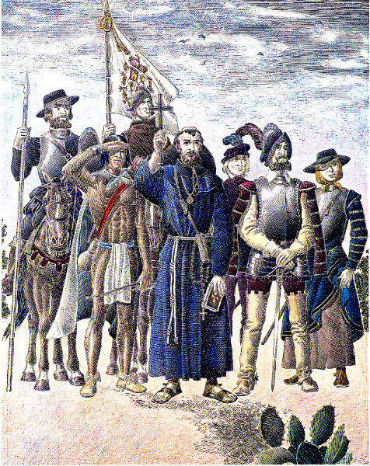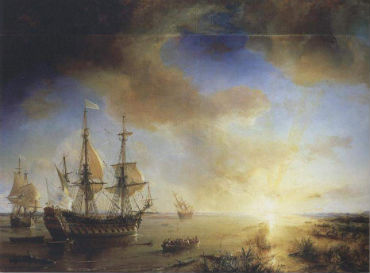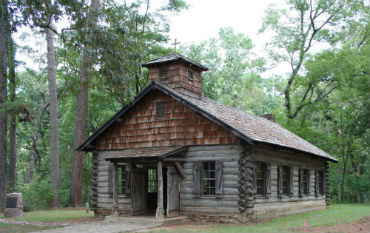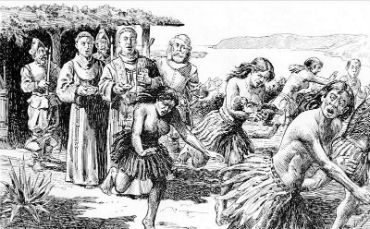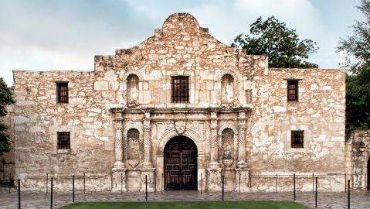Missionaries
An emissary of Church, or State?
The separation between church and state in 17th century Spain was so small as to be virtually unnoticeable.
First, a Series of Mistakes
For Spanish rulers in the late 1600s, there were two burning questions: 1) How do we secure our North American territorial claims in order to protect our Mexican silver mines, and 2) How do we gain more souls for the Catholic church? The answer to both questions came wearing a blue robe and a cross.
Missionaries and explorers had been wandering through Texas since the 1500s. The explorers were looking for gold while the missionaries were looking to spread the Gospel to the American Indians. Conquistadors such as Francisco Vázquez de Coronado, Hernando de Soto, and Álvar Núñez Cabeza de Vaca never found any gold and left disappointed and disillusioned. Many of the Franciscan friars were killed by the American Indians who were not especially interested in their message. By the middle of the 1600s, the Spanish had moved on, the Franciscans had returned to Mexico, and the missions near present-day San Angelo, El Paso, and Presidio, Texas were largely abandoned. And then René-Robert Cavalier, Sieur de La Salle, mistakenly sailed into Matagorda Bay.
Happy are those who endure in peace... St. Francis of Assisi
And I...remarked that I would take along three priests for the Texas, myself being the fourth, besides two for the mission of San Salvador, which is on the way, making a total of six priests to be sent by the college; and in the event of the Texas receiving the faith, then the college should send whatever other priests would be required. Father Damián Massenet
Church and State Head to Texas
La Salle's unexpected and mostly disastrous arrival in 1684 near present-day Corpus Christi sent Spain into a panicked frenzy. Spanish land in Texas had to be protected from French takeover at all costs. In 1686, Franciscan friar Father Damián Massenet and General Alonso de León, the Spanish embodiments of church and state, headed north from Mexico into Texas. Their first task was to find La Salle and his colony. After three years of searching, they did.
"April Friday the 22d, as we were near the settlement, our party set out though the day dawned rainy. Three leagues down the creek we found it. Having halted with the forces about an arquebus-shot away, we went to see it, and found all the houses sacked, all the chests, bottle-cases, and all the rest of the settlers’ furniture broken; apparently more than two hundred books, torn apart and with the rotten leaves scattered through the patios — all in French. We found three dead bodies scattered over the plain. One of these, from the dress that still clung to the bones, appeared to be that of a woman. We took the bodies up, chanted mass with the bodies present, and buried them. We looked for the other dead bodies but could not find them; whence we supposed that they had been thrown into the creek and had been eaten by alligators, of which there were many."
- General Alonso de León, 1689
"We saw no trace of Frenchmen having been there…except that certainly there were signs that the Indians had dwelt there. I myself set fire to the fort, and as there was a high wind – the wood, by the way, was from the sloop brought by the Frenchmen, which had sunk on entering the bay – in half an hour the fort was in ashes."
- Father Damián Massenet, 1689
In 1690, one year after Father Massenet set fire to La Salle's doomed Fort St. Louis settlement, he blessed the timber church of San Francisco de los Tejas – the first Spanish mission in east Texas, near present-day Augusta. Four months later, a second mission, Santísimo Nombre de María, was established a few miles to the east. By 1692, the Spanish state had two new colonial footholds in Texas. It appeared that the Catholic church also had a potentially willing population of converts in the Nabedache peoples of the Hasinai Confederacy.
I delivered to the [tribal] governor a staff with a cross, giving him the title of governor of all of his people...and giving him to understand by means of an interpreter that which he should observe and do...that he should make all his families attend Christian teaching, in order that they might be instructed in the affairs of our holy Catholic faith so that later they may be baptized and become Christians. He accepted the staff with much pleasure, promising to do all that we desired of him... General Alonso de León, 1689
It Worked in Theory...
In the idealized Spanish view of the mission plan, the result would be that the American Indians would become both good Catholics and good Spanish citizens. The Franciscan friars would be the instruments of instruction in a mission system that seemed both sound and even beneficial, at least to the Spanish. It would work like this. American Indians would report to the enclosed ground of the self-sufficient mission community where they would attend classes taught in non-native Spanish to learn about Christianity and the Catholic church. The Indians would work hard within the mission walls, planting and harvesting crops, maintaining buildings, and learning valuable Spanish trades. They would come to understand, care about, and want to be part of the Spanish culture. They would grow and mature in both spirituality and citizenship. The American Indians would be saved and "secularized" and would eventually be released from the mission system as valuable members of the Catholic church and Spanish Texas society.
Except that they wouldn't. By and large, most American Indians didn't want to be saved, secularized, or Spanish.
Spanish mission history in Texas repeated itself. American Indians didn't participate in the system, Franciscan friars were killed by hostile actions or disease, and the whole proposal mostly failed. By 1693, Santísimo Nombre de María mission had been washed away by Neches River flood waters and Father Massenet himself had burned San Francisco de los Tejas to the ground. The Spanish abandoned their efforts to establish missions in east Texas. Weary and discouraged, Franciscan friars walked home to Mexico. Again.
If one of them comes out peaceably to meet you, tell him to come forward, for we are not here to take away from them what they possess, or to hurt them; on the contrary, we wish to be their friend, and help them to our utmost. Father Damián Massenet, 1689
A Mission to Change History
In 1711, Friar Hidalgo wrote a secret letter to Antoine de la Mothe, Sieur de Cadillac, the French governor of Louisiana. Hidalgo asked the governor to help him reestablish the missions in east Texas. The friar, who had been with Massenet and de León at the first San Francisco mission, was angry that the Franciscans had abandoned the American Indians of Texas. In 1714, Cadillac sent a well-known French Canadian trader, Louis Juchereau de St. Denis, to convince the Spanish government that it was good business for both countries to rebuild the old mission forts. And, providing a system of new supply missions along the San Antonio River wasn't a bad idea, either.
In 1718, the supply mission of San Antonio de Valero was established. The Alamo. The history of Texas would never be the same.
Missionaries Timeline
Spanish conquistadors first crossed Texas in search of gold in New Mexico. By 1610, the Spanish had established a capital at Santa Fe. Their primary goals were to convert the American Indians to Christianity and to teach them to live according to Spanish culture. The Spanish crown commissioned Franciscan friars to establish missions. From the pueblos of New Mexico, a few priests began to venture into West Texas.
María de Jesús de Agreda was a nun who lived in Spain and had visions of sharing Christianity with people living in distant lands. Her visions were regarded as religious miracles. She was known as the "Woman in Blue" because of her blue Franciscan clothing. 17th century Spanish explorers describe the Jumano as asking for religious instruction to continue the teachings they had received during "visits" from the Woman in Blue. There is no evidence that Sister María left her convent in Spain to visit the Jumano in west Texas, which adds to the mystery of how the Jumano acquired their knowledge of Christianity before the Spanish arrived in Texas.
Fray Juan de Salas and Fray Diego León were the first Spanish missionaries in Texas. In 1629, they traveled to evangelize the Jumanos. In 1632, Juan de Salas and Juan de Ortega established a mission near present-day San Angelo. They were unable to supply or defend the outpost, and after six months, they were forced to abandon the mission.This arrow point is believed to be of Jumano origin.
Spanish shipwreck survivors under the leadership of Alvar Nuñez Cabeza de Vaca were the first Europeans to visit "La Junta de Rios," the junction of the Rio Grande and Rio Conchos, near present-day Presidio. Franciscans traveling through La Junta in 1581 performed the first Catholic mass in Texas. In 1670, Franciscans established a mission, but they were expelled after just two years.
In 1680, the Pueblo people rose up, killed 400 Spanish colonizers, and drove the remaining 2,000 Spanish out of New Mexico. The village of El Paso became the base of Spanish operations for the next 12 years. During this time, the Franciscans established the first successful missions in the El Paso area: Corpus Christi de Isleta, Nuestra Señora de la Limpia Concepción de Socorro, and San Antonio de Senecú.
In 1683 and 1684, the people of La Junta (near present-day Presidio) petitioned for missionaries to return to their area. Franciscans established two missions, El Apóstol Santiago on Alamito Creek and La Navidad en los Cruces along the Rio Grande. By 1688, these missions were abandoned.
By 1690, the Spanish realized the need to defend Texas against the French and blazed a network of trails from Mexico City to Louisiana. Missionaries traveled to East Texas along El Camino Real (the King's Highway). The missions of San Francisco de los Tejas and Santísimo Nombre de María were established along the Neches River. By 1693, both missions were abandoned.
From 1700 to 1713, Spain was involved in a European war, and New Spain (Texas) was not a priority. After the war, Franciscans returned to the Presidio area and established two missions, San Cristóbal and Santa María la Redonda de los Cibolos. Missionaries occupied the sites sporadically until the end of the Spanish era in Texas.
On May 1, 1718, the Spanish established a mission-presidio complex approximately midway between the Rio Grande Valley and the missions of East Texas. This was the founding of the city of San Antonio, the most significant Texas settlement of the Spanish era. The mission of San Antonio de Valero, later known as the Alamo, was moved to its present location in 1724.
The Franciscans turned new attention to East Texas beginning in 1716. They established a mission along the Neches River and built three additional missions in Nacogdoches County. In 1719, French troops attacked a nearby Louisiana mission in an event known to history as the Chicken War because it was little more than a raid on a henhouse. Nonetheless, the Spanish withdrew from East Texas for two years.
The East Texas missions were difficult to supply, staff, and defend, and most lasted only a few years. In 1730, three missions were relocated from East Texas to the site of present-day Austin. The following year, the missions were moved further south to San Antonio.
In 1757, the Spanish established Santa Cruz de San Sabá as a mission to the Apache. The Spanish also hoped to form an alliance with the Apache against the Comanche and allied northern tribes. In March of 1758, over 2,000 Comanche and allied norther tribes staged a massive attack, burning down the mission and killing all but one of the missionaries.
From People Across Texas
